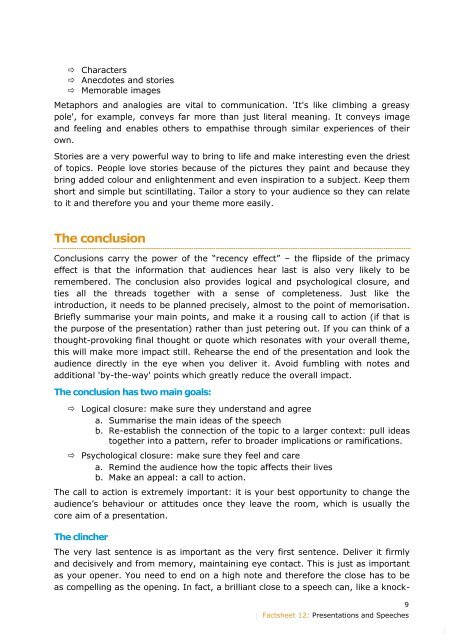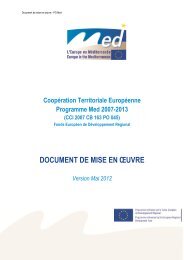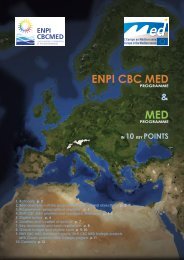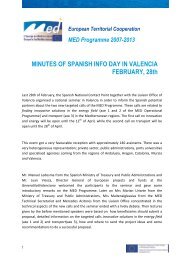MED Communication Handbook - Programme Med
MED Communication Handbook - Programme Med
MED Communication Handbook - Programme Med
You also want an ePaper? Increase the reach of your titles
YUMPU automatically turns print PDFs into web optimized ePapers that Google loves.
� Characters<br />
� Anecdotes and stories<br />
� Memorable images<br />
Metaphors and analogies are vital to communication. 'It's like climbing a greasy<br />
pole', for example, conveys far more than just literal meaning. It conveys image<br />
and feeling and enables others to empathise through similar experiences of their<br />
own.<br />
Stories are a very powerful way to bring to life and make interesting even the driest<br />
of topics. People love stories because of the pictures they paint and because they<br />
bring added colour and enlightenment and even inspiration to a subject. Keep them<br />
short and simple but scintillating. Tailor a story to your audience so they can relate<br />
to it and therefore you and your theme more easily.<br />
The conclusion<br />
Conclusions carry the power of the “recency effect” – the flipside of the primacy<br />
effect is that the information that audiences hear last is also very likely to be<br />
remembered. The conclusion also provides logical and psychological closure, and<br />
ties all the threads together with a sense of completeness. Just like the<br />
introduction, it needs to be planned precisely, almost to the point of memorisation.<br />
Briefly summarise your main points, and make it a rousing call to action (if that is<br />
the purpose of the presentation) rather than just petering out. If you can think of a<br />
thought-provoking final thought or quote which resonates with your overall theme,<br />
this will make more impact still. Rehearse the end of the presentation and look the<br />
audience directly in the eye when you deliver it. Avoid fumbling with notes and<br />
additional 'by-the-way' points which greatly reduce the overall impact.<br />
The conclusion has two main goals:<br />
� Logical closure: make sure they understand and agree<br />
a. Summarise the main ideas of the speech<br />
b. Re-establish the connection of the topic to a larger context: pull ideas<br />
together into a pattern, refer to broader implications or ramifications.<br />
� Psychological closure: make sure they feel and care<br />
a. Remind the audience how the topic affects their lives<br />
b. Make an appeal: a call to action.<br />
The call to action is extremely important: it is your best opportunity to change the<br />
audience’s behaviour or attitudes once they leave the room, which is usually the<br />
core aim of a presentation.<br />
The clincher<br />
The very last sentence is as important as the very first sentence. Deliver it firmly<br />
and decisively and from memory, maintaining eye contact. This is just as important<br />
as your opener. You need to end on a high note and therefore the close has to be<br />
as compelling as the opening. In fact, a brilliant close to a speech can, like a knock-<br />
� Factsheet 12: Presentations and Speeches<br />
9<br />
�








